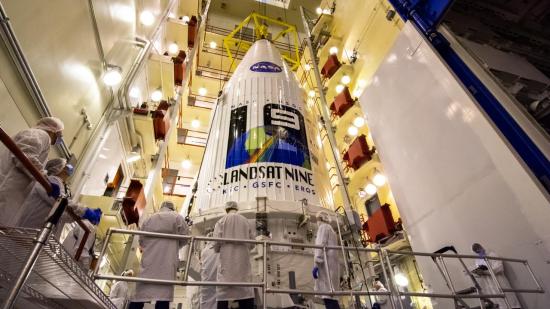By Laura E.P. Rocchio, Landsat Communication and Public Engagement
The Landsat 9 observatory, safely encapsulated in its rocket fairing, now sits atop the United Launch Alliance (ULA) Atlas V 401 launch vehicle on its Vandenberg Space Force Base (VSFB) launch pad.
“This is one of the major milestones in the processing operations involving both the observatory team and the launch vehicle team,” explained John Satrom, the NASA Landsat 9 Launch Integration Manager. “Once the observatory is mated to the launch vehicle, ULA assumes responsibility for the health and safety of Landsat 9 as we jointly make the final preparations for launch.”
Landsat 9 is now scheduled for launch no earlier than Monday, Sept. 27, 2021, within a 30-minute launch window starting at 11:11 a.m. U.S. Pacific Daylight Time.
In preparation for launch, Landsat 9 was successfully joined, or mated, with the rest of the Atlas V launch vehicle in the early morning hours of Wednesday, September 15, 2021.
Mating takes place after the launch vehicle goes through a wet dress rehearsal. The wet dress rehearsal is a fueled-run of the rocket launch sequence that takes place without starting the engines and without having the rocket fairing and satellite on-board. The wet dress rehearsal ensures that the Atlas V launch vehicle and ground support equipment at the launch pad are performing as expected prior to attaching the payload—the Landsat 9 observatory.

To prepare for the mating, the encapsulated Landsat 9 observatory was lifted with a crane from its former location in the L3Harris Integrated Processing Facility and placed onto a transporter truck especially equipped to keep the Landsat 9 observatory cool, dry, and clean (instruments are kept under positive pressure with gaseous nitrogen during transport).
The encapsulated Landsat 9 observatory was then driven to the launch pad, Space Launch Complex-3 (SLC-3)—the only Atlas launch pad on the West Coast.
Landsat 9’s arrival at SLC-3 was carefully timed so that the lifting of the fairing to the top of the launch vehicle could take place first thing in the morning when temperatures are coolest and winds most benign. Out-of-tolerance high winds prohibited a previously planned Saturday morning mating.
After its predawn arrival on Sept. 15, the Landsat 9 fairing was hoisted to the top of the launch vehicle using an overhead bridge crane within the Mobile Service Tower at SLC-3. Once centered over the launch vehicle, the fairing was attached using specialized bolts.
Throughout the entire mating process, the Landsat 9 observatory was kept under careful temperature, humidity, and cleanliness control to protect its instruments.
The encapsulated Landsat 9 observatory now sits at the top of the 194-foot (59.1-meter) Atlas V 401 launch vehicle awaiting its upcoming launch.
Landsat 9 is a joint mission of NASA and the U.S. Geological Survey. Landsat 9 is the most advanced satellite in the Landsat series; it will extend the data record of Earth’s land surface that began with the first Landsat satellite in 1972. Landsat’s high-quality scientific data makes multi-decadal time series studies possible, and its data are regularly used for land management efforts around the world.
Related Reading:
+ Landsat 9: Payloads stacked atop Atlas V for launch, United Launch Alliance





